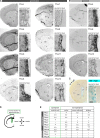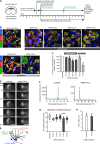Tubulin glycylases and glutamylases have distinct functions in stabilization and motility of ependymal cilia
- PMID: 23897886
- PMCID: PMC3734080
- DOI: 10.1083/jcb.201305041
Tubulin glycylases and glutamylases have distinct functions in stabilization and motility of ependymal cilia
Abstract
Microtubules are subject to a variety of posttranslational modifications that potentially regulate cytoskeletal functions. Two modifications, glutamylation and glycylation, are highly enriched in the axonemes of most eukaryotes, and might therefore play particularly important roles in cilia and flagella. Here we systematically analyze the dynamics of glutamylation and glycylation in developing mouse ependymal cilia and the expression of the corresponding enzymes in the brain. By systematically screening enzymes of the TTLL family for specific functions in ependymal cilia, we demonstrate that the glycylating enzymes TTLL3 and TTLL8 were required for stability and maintenance of ependymal cilia, whereas the polyglutamylase TTLL6 was necessary for coordinated beating behavior. Our work provides evidence for a functional separation of glutamylating and glycylating enzymes in mammalian ependymal cilia. It further advances the elucidation of the functions of tubulin posttranslational modifications in motile cilia of the mammalian brain and their potential importance in brain development and disease.
Figures





Similar articles
-
Tubulin tyrosine ligase-like genes ttll3 and ttll6 maintain zebrafish cilia structure and motility.J Biol Chem. 2011 Apr 1;286(13):11685-95. doi: 10.1074/jbc.M110.209817. Epub 2011 Jan 24. J Biol Chem. 2011. PMID: 21262966 Free PMC article.
-
Crystal structure of tubulin tyrosine ligase-like 3 reveals essential architectural elements unique to tubulin monoglycylases.Proc Natl Acad Sci U S A. 2017 Jun 20;114(25):6545-6550. doi: 10.1073/pnas.1617286114. Epub 2017 Jun 2. Proc Natl Acad Sci U S A. 2017. PMID: 28576883 Free PMC article.
-
Alterations in the balance of tubulin glycylation and glutamylation in photoreceptors leads to retinal degeneration.J Cell Sci. 2017 Mar 1;130(5):938-949. doi: 10.1242/jcs.199091. Epub 2017 Jan 19. J Cell Sci. 2017. PMID: 28104815
-
Ependymal cell differentiation, from monociliated to multiciliated cells.Methods Cell Biol. 2015;127:19-35. doi: 10.1016/bs.mcb.2015.01.004. Epub 2015 Mar 7. Methods Cell Biol. 2015. PMID: 25837384 Review.
-
Chlamydomonas as a tool to study tubulin polyglutamylation.Microscopy (Oxf). 2019 Feb 1;68(1):80-91. doi: 10.1093/jmicro/dfy044. Microscopy (Oxf). 2019. PMID: 30364995 Review.
Cited by
-
Microtubule modification defects underlie cilium degeneration in cell models of retinitis pigmentosa associated with pre-mRNA splicing factor mutations.Front Genet. 2022 Sep 13;13:1009430. doi: 10.3389/fgene.2022.1009430. eCollection 2022. Front Genet. 2022. PMID: 36176300 Free PMC article.
-
Native doublet microtubules from Tetrahymena thermophila reveal the importance of outer junction proteins.Nat Commun. 2023 Apr 15;14(1):2168. doi: 10.1038/s41467-023-37868-0. Nat Commun. 2023. PMID: 37061538 Free PMC article.
-
Posttranslational Modifications of Tubulin and Cilia.Cold Spring Harb Perspect Biol. 2017 Jun 1;9(6):a028159. doi: 10.1101/cshperspect.a028159. Cold Spring Harb Perspect Biol. 2017. PMID: 28003186 Free PMC article. Review.
-
Microtubule glycylation promotes attachment of basal bodies to the cell cortex.J Cell Sci. 2019 Aug 7;132(15):jcs233726. doi: 10.1242/jcs.233726. J Cell Sci. 2019. PMID: 31243050 Free PMC article.
-
Spatiotemporal manipulation of ciliary glutamylation reveals its roles in intraciliary trafficking and Hedgehog signaling.Nat Commun. 2018 Apr 30;9(1):1732. doi: 10.1038/s41467-018-03952-z. Nat Commun. 2018. PMID: 29712905 Free PMC article.
References
-
- Bell P.B., Jr, Safiejko-Mroczka B. 1995. Improved methods for preserving macromolecular structures and visualizing them by fluorescence and scanning electron microscopy. Scanning Microsc. 9:843–857, discussion :858–860 - PubMed
-
- Bré M.H., Redeker V., Quibell M., Darmanaden-Delorme J., Bressac C., Cosson J., Huitorel P., Schmitter J.M., Rossler J., Johnson T., et al. 1996. Axonemal tubulin polyglycylation probed with two monoclonal antibodies: widespread evolutionary distribution, appearance during spermatozoan maturation and possible function in motility. J. Cell Sci. 109:727–738 - PubMed
-
- Carlén M., Meletis K., Göritz C., Darsalia V., Evergren E., Tanigaki K., Amendola M., Barnabé-Heider F., Yeung M.S.Y., Naldini L., et al. 2009. Forebrain ependymal cells are Notch-dependent and generate neuroblasts and astrocytes after stroke. Nat. Neurosci. 12:259–267 10.1038/nn.2268 - DOI - PubMed
Publication types
MeSH terms
Substances
LinkOut - more resources
Full Text Sources
Other Literature Sources
Molecular Biology Databases

